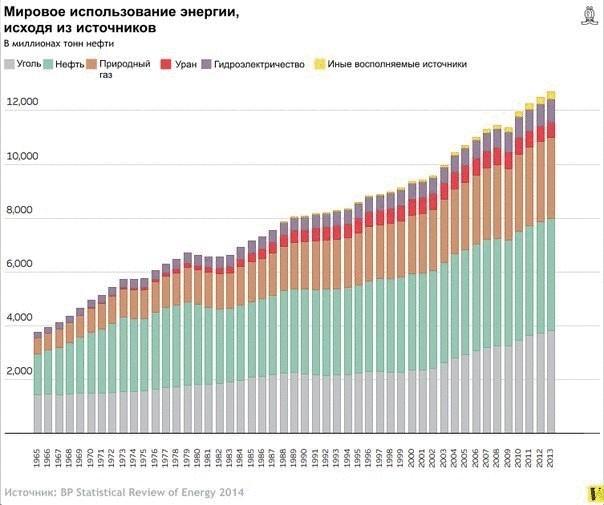When "green" energy for fossil fuels will win
 Bashny.Net
Bashny.Net
Many decades of traditional fuels provide most of the demand for energy. But in recent years with amazingly rapidly develop methods of producing energy from cleaner sources, like wind and solar radiation.Now many are thinking that when will be the tipping point in the use of clean energy. When fossil fuels finally surrender their positions? This неделеBloomberg announced that the time has come: "Fossil fuels lost the race against renewable energy." This statement caused a wide public resonance.
Unfortunately, this is not the right title. Green energy did not win the race against fossil fuels. Yet. And the reasons are worth exploring in more detail to better understand how big is the challenge before us is to make all electricity in the world clean and to avoid global warming.
Key argument Bloomberg is a chart taken from the Bloomberg New Energy Finance shows that in 2013, countries around the world have increased their power largely at the expense of hydropower, nuclear, solar, wind, geothermal and biomass than for an oil, gas or coal:

Great argument. But it does not prove that the use of green energy is growing faster than the use of traditional. In this table, missed two important facts:
1. Electricity is not the same as energy. The first thing to note: the chart above only shows the added electric power. You need to remember, "electricity" is not the same as "energy". We use electricity for our homes and appliances, but most of the cars and planes in the world do not work on electricity, and on oil. In many buildings is used for heating not electricity, and gas. These energy sources are not taken into account above.
However, if we are concerned about global warming, you should look at the situation globally. In 2012, electricity and heat accounted for only about 42 percent of the world's CO2 emissions. In order to really win the race with traditional fuels, "green" energy will have to make a breakthrough in other areas, particularly in the transport sector.
2. One GW of electricity generated by solar energy is not equal to one GWh generated by burning coal. A second disadvantage of the graph above is that it shows only added electrical power. "Power" is defined as the maximum amount of energy that can produce power under certain conditions. It is not the same as how much electricity a power plant actually can produce during operation.
Here's how you can illustrate the difference: coal-fired power plant can burn fuel almost around the clock. Thus, in the long term, coal-fired plants generally produce about 50 to 80 percent of its maximum capacity.
Photovoltaic solar panels, by contrast, tend to work only when the sun shines. Ultimately, they can only produce 20 percent of their maximum capacity. These percentages are known as the "performance factors".
This fact is very important to keep in mind. Imagine that worldwide installed "solar panel" with a total capacity of 2 GW coal-fired power plant with a capacity of 1 GW. If you compare only the graphics of their capacity, then immediately come to the conclusion that solar energy is without a doubt wins coal. But this is not always the case. If you subtract the performance factors it is likely that more electricity will be generated by using coal.
So, let's look at a more accurate chart — table world consumption of energy from various sources. Thus, we see the consumption of all primary energy — not only electricity, but also cars, airplanes, heating and so on. We are also not deluded by the total power, and look at the actual consumption.
As is often the case, BP is offering us this data in its Statistical review of world energy for 2014. In the table below for "green" energy, it looks not so rosy:

Overall, in 2013, 87 percent of the total primary energy consumption in the world has had on fossil fuels, while, energy sources with low carbon — including nuclear energy, hydropower, wind, solar and biomass — accounted for only 13 percent.
According to Roger pielke Jr. from Colorado state University, this ratio has not changed since 1999. Energy consumption in the world during this time, did not become cleaner or one per cent.
So, Yes, consumption of "green" energy grows with time. This small yellow segment reflecting renewable energy increases very quickly.
The use of hydropower is also increasing. (Nuclear power, by contrast, stagnated.) But coal, natural gas, oil not far behind, and even overtake.
A good example: in 2013, the consumption of renewable energy excluding hydro power grew by 38.5 mtoe (tons of oil equivalent). But coal consumption rose 103t.N. e., more than two times. These numbers show us a very different situation.As of 2013, fossil fuels still win the race.
There is a reason to look at the prospects of clean energy with optimism, but we have to meet the challenge
Well, this article is not meant as a pessimistic note on renewable sources of energy. Chart Bloomberg still can learn a good news about green energy and exactly what the world is building more and more power plants working on solar energy, wind and water, while the growth rate of the added capacity at the expense of fossil fuels slow down.
Moreover, in the field of clean energy, there are many encouraging trends. The cost of wind and solar energy has dramatically decreased worldwide. The price of batteries for electric vehicles have fallen much faster than expected (which is very important, as the production of cars running on green electricity, is an important part of 'greening' the energy supply). Meanwhile, China has begun cracking down coal-fired power plants, in an attempt to stop air pollution.
Given these trends, it is likely that in the near future there will come a time when worldwide consumption of clean energy will grow faster than fossil fuel consumption. Maybe we get closer to this tipping point. Maybe we'll get to it in 2020. All this is very difficult to predict. But when it happens, the proportion of energy we get from sources with low carbon emissions will begin to expand, and the proportion of energy derived from fossil fuels will be reduced.
However, if the world wants to avoid drastic global warming, little progress in the field of renewable energy is insufficient. You want real breakthrough — the share of energy that we get from carbon-free sources in this century is expected to increase from 13 per cent to about 90. published
P. S. And remember, only by changing their consumption — together we change the world! ©
Source: smoozi.ru/technology/green_energy.html
Unfortunately, this is not the right title. Green energy did not win the race against fossil fuels. Yet. And the reasons are worth exploring in more detail to better understand how big is the challenge before us is to make all electricity in the world clean and to avoid global warming.
Key argument Bloomberg is a chart taken from the Bloomberg New Energy Finance shows that in 2013, countries around the world have increased their power largely at the expense of hydropower, nuclear, solar, wind, geothermal and biomass than for an oil, gas or coal:

Great argument. But it does not prove that the use of green energy is growing faster than the use of traditional. In this table, missed two important facts:
1. Electricity is not the same as energy. The first thing to note: the chart above only shows the added electric power. You need to remember, "electricity" is not the same as "energy". We use electricity for our homes and appliances, but most of the cars and planes in the world do not work on electricity, and on oil. In many buildings is used for heating not electricity, and gas. These energy sources are not taken into account above.
However, if we are concerned about global warming, you should look at the situation globally. In 2012, electricity and heat accounted for only about 42 percent of the world's CO2 emissions. In order to really win the race with traditional fuels, "green" energy will have to make a breakthrough in other areas, particularly in the transport sector.
2. One GW of electricity generated by solar energy is not equal to one GWh generated by burning coal. A second disadvantage of the graph above is that it shows only added electrical power. "Power" is defined as the maximum amount of energy that can produce power under certain conditions. It is not the same as how much electricity a power plant actually can produce during operation.
Here's how you can illustrate the difference: coal-fired power plant can burn fuel almost around the clock. Thus, in the long term, coal-fired plants generally produce about 50 to 80 percent of its maximum capacity.
Photovoltaic solar panels, by contrast, tend to work only when the sun shines. Ultimately, they can only produce 20 percent of their maximum capacity. These percentages are known as the "performance factors".
This fact is very important to keep in mind. Imagine that worldwide installed "solar panel" with a total capacity of 2 GW coal-fired power plant with a capacity of 1 GW. If you compare only the graphics of their capacity, then immediately come to the conclusion that solar energy is without a doubt wins coal. But this is not always the case. If you subtract the performance factors it is likely that more electricity will be generated by using coal.
So, let's look at a more accurate chart — table world consumption of energy from various sources. Thus, we see the consumption of all primary energy — not only electricity, but also cars, airplanes, heating and so on. We are also not deluded by the total power, and look at the actual consumption.
As is often the case, BP is offering us this data in its Statistical review of world energy for 2014. In the table below for "green" energy, it looks not so rosy:

Overall, in 2013, 87 percent of the total primary energy consumption in the world has had on fossil fuels, while, energy sources with low carbon — including nuclear energy, hydropower, wind, solar and biomass — accounted for only 13 percent.
According to Roger pielke Jr. from Colorado state University, this ratio has not changed since 1999. Energy consumption in the world during this time, did not become cleaner or one per cent.
So, Yes, consumption of "green" energy grows with time. This small yellow segment reflecting renewable energy increases very quickly.
The use of hydropower is also increasing. (Nuclear power, by contrast, stagnated.) But coal, natural gas, oil not far behind, and even overtake.
A good example: in 2013, the consumption of renewable energy excluding hydro power grew by 38.5 mtoe (tons of oil equivalent). But coal consumption rose 103t.N. e., more than two times. These numbers show us a very different situation.As of 2013, fossil fuels still win the race.
There is a reason to look at the prospects of clean energy with optimism, but we have to meet the challenge
Well, this article is not meant as a pessimistic note on renewable sources of energy. Chart Bloomberg still can learn a good news about green energy and exactly what the world is building more and more power plants working on solar energy, wind and water, while the growth rate of the added capacity at the expense of fossil fuels slow down.
Moreover, in the field of clean energy, there are many encouraging trends. The cost of wind and solar energy has dramatically decreased worldwide. The price of batteries for electric vehicles have fallen much faster than expected (which is very important, as the production of cars running on green electricity, is an important part of 'greening' the energy supply). Meanwhile, China has begun cracking down coal-fired power plants, in an attempt to stop air pollution.
Given these trends, it is likely that in the near future there will come a time when worldwide consumption of clean energy will grow faster than fossil fuel consumption. Maybe we get closer to this tipping point. Maybe we'll get to it in 2020. All this is very difficult to predict. But when it happens, the proportion of energy we get from sources with low carbon emissions will begin to expand, and the proportion of energy derived from fossil fuels will be reduced.
However, if the world wants to avoid drastic global warming, little progress in the field of renewable energy is insufficient. You want real breakthrough — the share of energy that we get from carbon-free sources in this century is expected to increase from 13 per cent to about 90. published
P. S. And remember, only by changing their consumption — together we change the world! ©
Source: smoozi.ru/technology/green_energy.html
Tags
See also
Israel - solar energy will replace diesel fuel
76 days in a row Costa Rica lives without fossil fuels
Mankind is able to abandon fossil fuels over a period of ten years
The current status of solar energy in the conditions of U.S. households
The turning point in the search for clean energy sources
Elon Musk: the burning of fossil fuels is the stupidest experiment ever
The era of fossil fuels coming to an end
Unexpected sources of energy that can save the world
White house moves to "green" energy
Tokelau — the world's first "solar" state

















